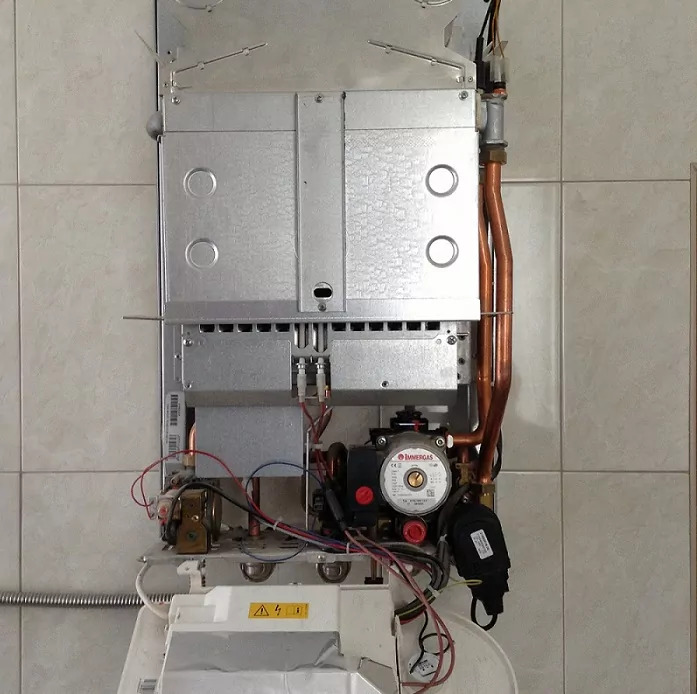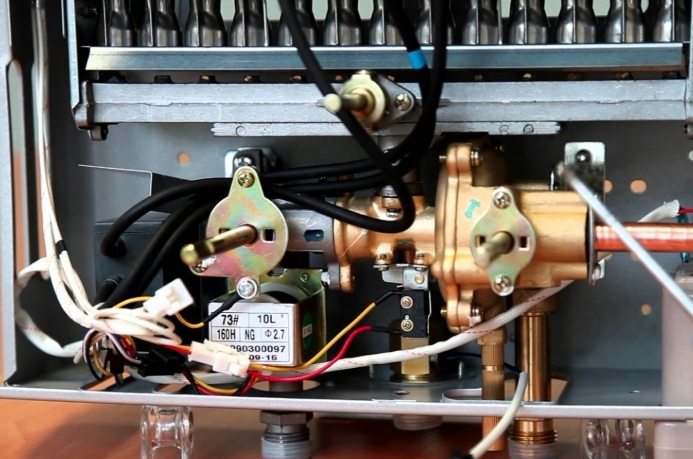Isn't it true, having spent money on the installation of the column, you want to always have hot water at a given temperature in the house? But even the most modern equipment fails. What to do if an icy stream is pouring out of the tap, or vice versa - boiling water?
Is it possible to repair gas water heaters with your own hands or is it better to call gas workers? Let's decide together what problems with water heating equipment can be solved independently. We will analyze and list for which problems a wizard is definitely needed.
From the article we have presented, you will learn how to restore the operability of a gas unit and how to adjust it to the optimal mode. We will introduce you to the typical design of blue fuel devices and their typical operating errors.
The content of the article:
- Construction of gas water heaters
-
Features of diagnostics and repair
- Why does water heat up badly?
- What if the speaker won't turn on?
- The burner goes out spontaneously
- The burner operates with the valve closed
- Leakage through plug connections
- The water heater makes a lot of noise
- Security issues
- Pressure testing of the water circuit
- Temperature and water flow control
- Conclusions and useful video on the topic
Construction of gas water heaters
To repair any equipment, you need to know its design features.
Gas water heaters of 3 main types are used for household needs:
- accumulative;
- flowing;
- combined.
Most popular gas instantaneous water heaters. Abbreviated as ГПВН. GOST defines them as instantaneous water heaters. In such devices, the water heats up only when the tap is turned on.

The standard HPVN scheme includes many elements, grouped depending on the functions performed: path, combustion path, water circuit, etc. For example, burners belong to the gas path, and the heat exchanger belongs to the gas path. combustion
Technical requirements for household flowing gas water heaters equipped with atmospheric burners are established by GOST R 51847-2009. Their classification is also given there.
Features of diagnostics and repair
Manufacturers usually indicate in the accompanying documentation that only employees of the service company should carry out the repair of the HPVN.
In accordance with the requirements of labor protection, such work is performed by adults who have undergone professional training and are licensed by Gospromnadzor.
If, nevertheless, you decide to eliminate minor defects on your own, you should remember about the explosion hazard and suffocating the action of liquefied and natural gas, be prepared for emergency situations, be able to use the means fire protection.
Please note that the same hardware problem can be caused by different reasons. For example, you turn on a hot water tap, but the gas water heater does not turn on. This may be due to dirty filters, breakdown of controls and about a dozen other reasons.
Both home craftsmen and representatives of service companies face difficulties in diagnostics. But gas workers have experience and professional equipment, which greatly facilitates and speeds up the solution of the problem. The home craftsman is often armed only with a screwdriver and an adjustable wrench.
Before embarking on self-repair, adequately assess your resources, weigh the pros and cons. This will help you save time and avoid risks.

Do not forget that all repair operations for which it is necessary to remove the front panel of the case or completely remove, must be carried out by gas workers from the organization with which a contract for the maintenance and supply of gaseous fuel. In case of independent intervention, the manufacturer's warranty will be canceled.
If the warranty period has long expired, you can perform the simplest steps to restore the operability of the gas water heater yourself. When identifying the causes of malfunctions, you do not need to immediately dismantle and disassemble the device.
Proceed from simple to complex, first check:
- are the water and gas stopcocks open;
- is there gas in the cylinder (if the column runs on liquefied fuel);
- whether the batteries are installed correctly in the battery compartment and whether there is a charge.
This principle works for most common faults. In the future, we will not return to it, assuming that you have already carried out the primary diagnostics, but it was not possible to do with "little blood".
Why does water heat up badly?
Over time, the burner channels accumulate dust, and soot deposits on the fins of the heat exchanger. As a result, the real heating capacity drops and barely warm water runs out of the tap. Associated problems: the column does not turn on, the burners smoke and go out spontaneously.

The water entering the heat exchanger from a well or water supply contains magnesium and calcium salts. When heated, they settle on the inner surfaces of the heat exchanger in the form of scale
The thermal conductivity of stainless steel and copper, from which the heat exchangers are made, is 45 and 401 W / m2 × K, respectively. These indicators vary slightly depending on the grade of the metal. Thermal conductivity of scale is much lower - only about 0.2 W / m2× K.
This means that even a small deposit on the walls of the heat exchanger leads to a decrease in heat transfer. As a result, the water heating time increases. Deposits reduce the flow area, which reduces the flow of water.
How do I clean the heat exchanger?
At home, a predominantly chemical method is used. It is versatile and suitable for both gasketed and welded / brazed heat exchangers. Special detergents are used that do not react with metal, but dissolve carbonate deposits.
Before cleaning, you must:
- shut off the gas and water supply;
- drain the remaining water by turning on the tap;
- remove the protective cover;
- disconnect the supply pipes and wires;
- remove the heat exchanger.
Pour warm water with dishwashing liquid into a deep basin. Place the heat exchanger and the gas burner unit in the basin. Clean the soot from the radiator grill with a soft brush, rinse the parts with a stream of clean water, not forgetting about the channels through which the gas is supplied to the burner.
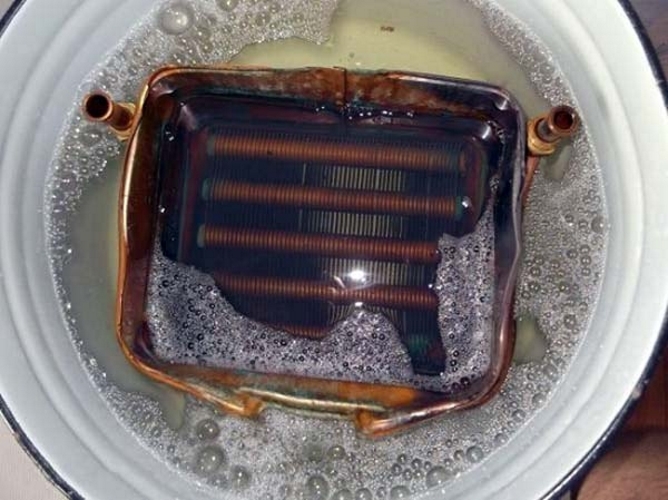
To remove scale, install the heat exchanger in the basin upside down (downward with the radiator and upward inlet and outlet of the tube). Pour anti-scale agent into the tube. After the limescale has dissolved, drain the liquid and thoroughly rinse the heat exchanger. Reassemble and connect
The plate heat exchanger can be carefully disassembled before cleaning. At the same time, do not miss the opportunity to examine it and assess its condition. If the wear on the plates is significant, it is best to replace them immediately. With a small layer of scale, instead of special liquids, you can use ordinary table vinegar or citric acid solution.
The flushing time varies from 30 minutes to a day or more, depending on the properties of the detergent and the thickness of the deposits. After eliminating contamination, the heat engineering indicators of the column must correspond to those indicated in the passport.
Prevention of scale formation
The use of faucets in the water supply system involves mixing cold and hot water. This method accelerates the formation of scale. It is recommended to use a separate tap for hot water, and a gas flow regulator will help to increase or decrease its temperature.
If, when heating water, its temperature often rises above 60 degrees, scale forms faster. Do not fill the bath with boiling water for later dilution with cold water. Adjust the device correctly, and water at a comfortable temperature will come directly from the tap. The recommended temperature for bath and shower is within 37-42 degrees.
The rapid accumulation of soot is caused by prolonged heating of water at the maximum flame of the burners, poor draft chimney, incomplete combustion of gas and the presence of impurities in it.
What if the speaker won't turn on?
Have you turned on a hot water tap, but there is no spark and the gas flow heater does not ignite? Carbon deposits may have formed on the spark plug electrodes. On many models, these parts can be cleaned through the viewing window using a long-handled brush.
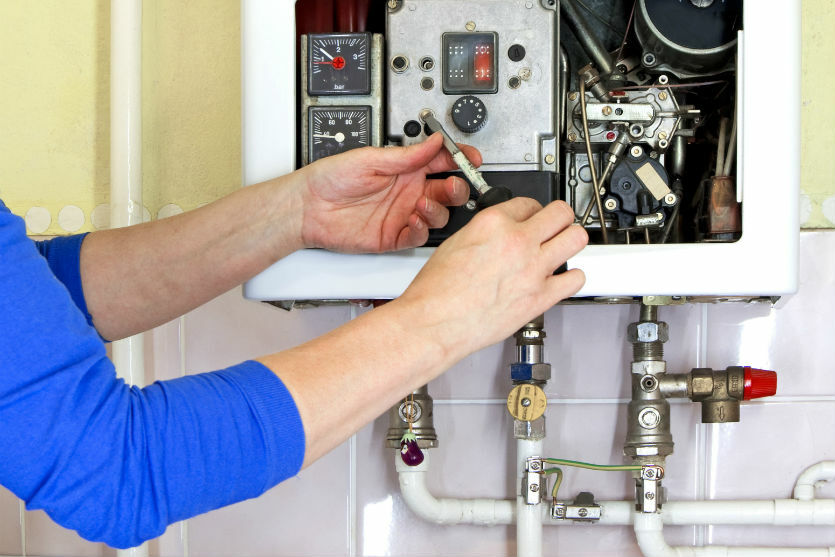
Sometimes water heaters do not work due to weak water pressure. Check the filter and if necessary clean or replace it, rinse the heat exchanger. Open the shut-off valve fully. If the head remains weak, contact the management company (housing and communal services).
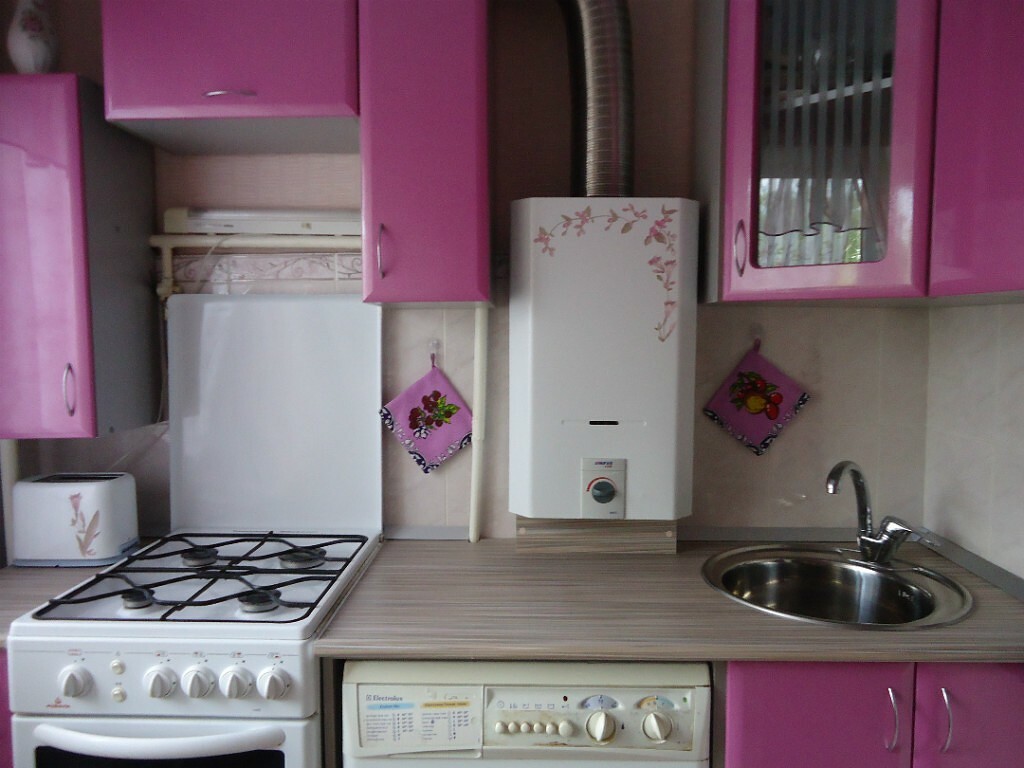
Difficulties in igniting the gas column are often caused by damage to the elastic membrane located at the beginning of the water circuit. When the valve is opened, a pressure drop occurs, due to which the membrane bends and acts on the gas valve through the stem. As a result, the gas flows to the burners.
With repeated bending, the membrane wears out, stretches, breaks and no longer performs its functions properly. Losing elasticity or integrity, it is not able to press on the stem with sufficient force. Gas valve does not open or does not open fully.
Due to lack of fuel, the water heater does not work. The membrane replacement algorithm is as follows:
- shutting off the water and gas supply;
- removing the casing;
- disconnecting pipes and wires;
- removal and replacement of the membrane;
- reassembly.
Upon completion of the work, using a soap solution, the tightness of the detachable joints is checked.
The burner goes out spontaneously
A water heater with an open combustion chamber turns on normally, but during operation its nozzles go out. This problem may be associated with a lack of air, which is taken directly from the room where the device is located.
With tightly closed plastic windows, air exchange with the street is difficult, which leads to the activation of the protection system and the burner flame goes out.

Blocking the operation of a gas water heater can occur due to a weak exhaust of flue gases. A common cause of this problem is a clogged chimney.
Open the window a little, wait about 10 minutes and turn on the column. If it goes out again, check the flue gas path. For water heaters with atmospheric burners, these are the usual chimneyswith natural cravings.
Gasmen check traction with an anemometer. The device allows you to determine the volume of air passing through the chimney. Home craftsmen use thin paper, which must be cut into strips about 2 cm wide and about 20 cm long and brought to the chimney inlet at a distance of 5 cm.
First, turn off the column, remove the gas outlet pipe and open the window. If the paper strips are not carried away by the air flow and do not touch the chimney inlet, then it is time to clean it.
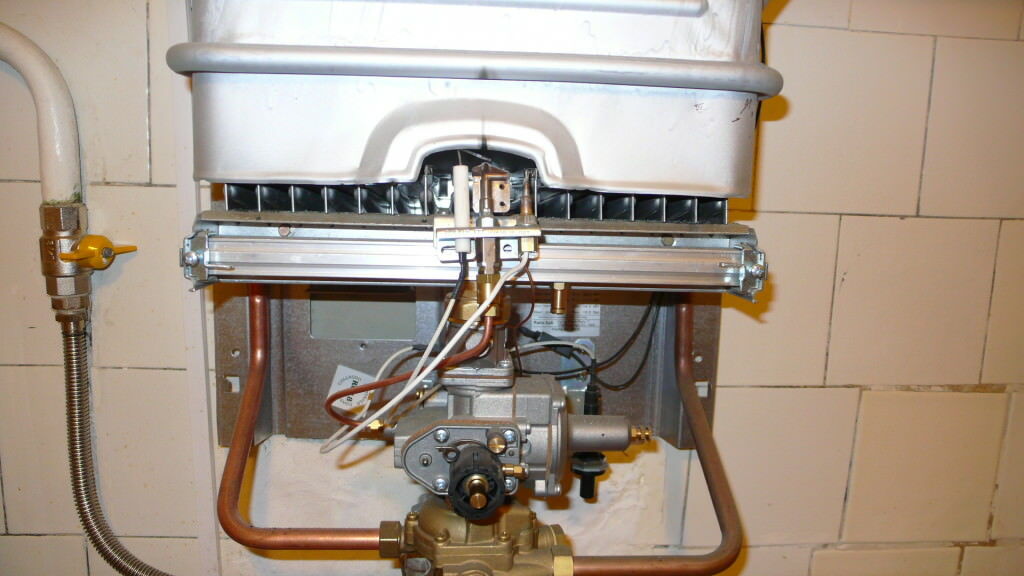
The ignition device does not work if the gas supply is interrupted, or if the spark plug is clogged or smoked. Also, the reasons include a breakdown of the transformer of the ignition device or a violation of the electrical circuit connected to it.
Please note that gas leaks will accumulate in the outlet shafts. Therefore, you should not tempt fate by testing cravings with a burning match, candle or lighter.
The burner operates with the valve closed
Have you turned off the hot water tap, but the burner is not going to go out? Most likely, the stem of the gas or water circuit is jammed. This is the case when you cannot do without specialists.
But first of all, it is necessary to block the access of gas to the device by closing the shut-off valve on the gas main, and only then call the service department.
Leakage through plug connections
The shut-off valve is installed on the cold water inlet pipe using a threaded union nut. The pipe through which hot water enters the water supply system is connected to the heat exchanger pipe in the same way.
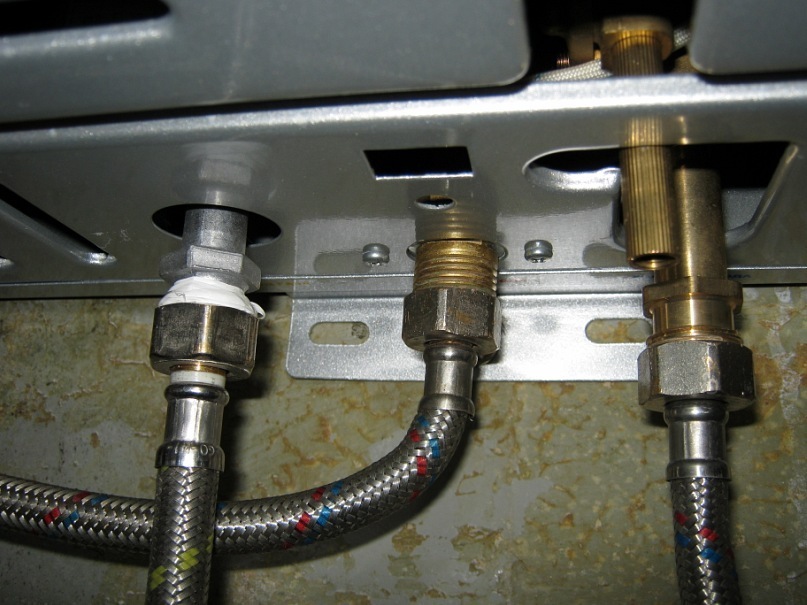
All detachable connections of the water circuit are sealed with gaskets made of non-asbestos paronite, Teflon or oil and petrol resistant rubber. The wear of the gaskets leads to a violation of the sealing of the joints and leaks
Before replacing the gasket, the column turns off, the water in the water supply system is shut off, the nuts are unscrewed, the worn out gaskets are removed and new ones are installed in their place.
The water heater makes a lot of noise
Serviceable gas equipment works very quietly and this is one of its advantages.
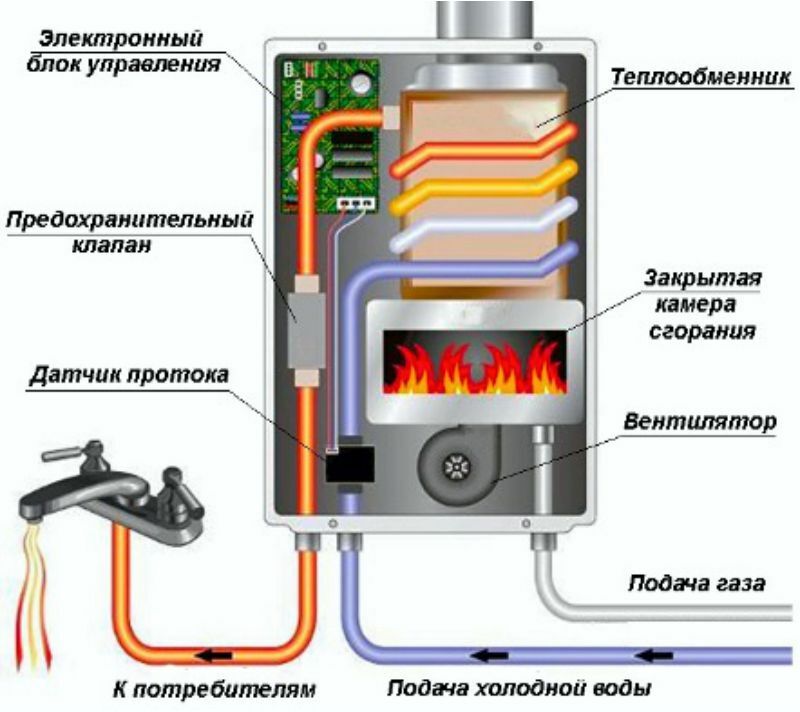
Gas water heaters with a closed combustion chamber are equipped with fans that blow in the air required for combustion and remove the flue gases
An increased noise level indicates excessive water flow in the heat exchanger or overheating.
Measure the temperature of the water in the tap and, depending on the result, adjust the water or gas flow in the direction of decrease.
Security issues
In order for HPVNs to meet safety requirements, manufacturers equip them with a variety of sensors. If the burner goes out for some reason, and gas continues to flow, the gas-air mixture may explode.
This development of the situation helps to prevent the flame detector. Ionization currents arise between its control electrode and the burner flame, on the basis of which discrete signals are formed. In the absence of a flame, the shut-off valves operate and the gas supply is interrupted.
If the sensor is installed in such a way that the electrode touches the burner parts or is too far from the flame, its correct operation becomes impossible. This turns off the speaker. To solve the problem, it is enough to change the position of the electrode.
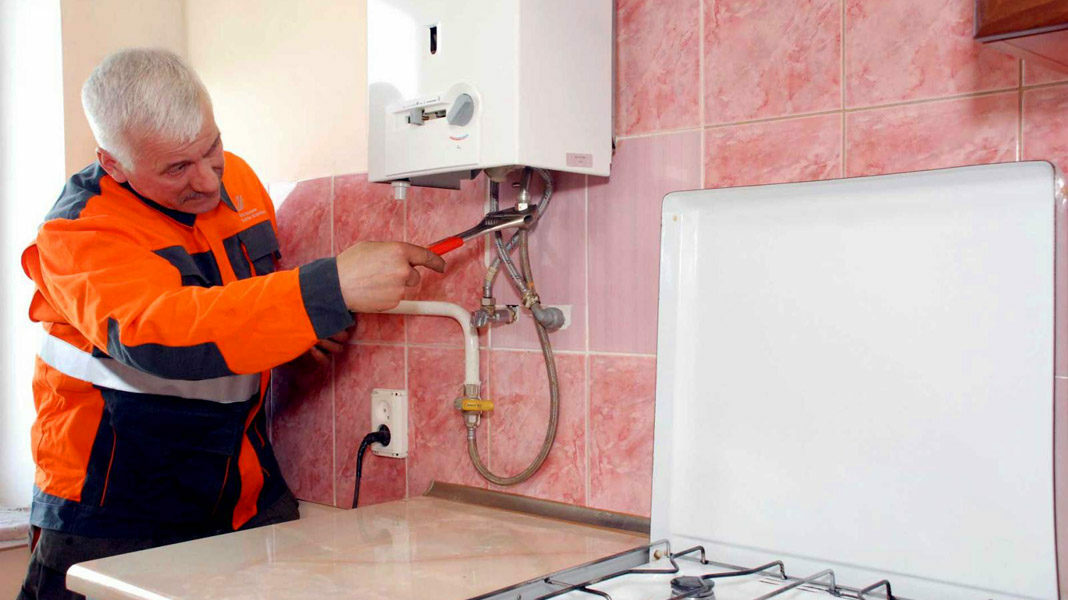
To control the water temperature, an overheating sensor is installed on the heat exchanger tube. Usually it is a thermostat with bimetallic temperature-sensitive elements.
When the water temperature approaches the boiling point (85 ° C), the shape of the temperature-sensitive elements changes, which leads to the opening of the electrical power circuit of the electronic unit and the column turns off.
A breakdown of the overheating sensor, a break in the electrical circuit lead to a premature shutdown of the column, even if the water did not have time to heat up.
Eliminating other possible causes of the malfunction, use a multimeter to check the integrity of the current-carrying conductors of the electrical circuit. If there are no breaks, check the sensor and, if necessary, replace it with a serviceable one.
To do this, disconnect both wires from the sensor, unscrew the fastening screws that fix the device to the heat exchanger. Now it remains to remove the old sensor and install a new one.
Pressure testing of the water circuit
After repairing a gas water heater with disassembling the water circuit, it is necessary to check the tightness of pipes and joints. The most effective method is crimping. Fill the circuit with water, the temperature of which is from 5 ° C to 25 ° C. In this case, the air temperature in the room must be above 0 ° С.
Using a manual or electric pump, raise the pressure in the circuit to the test value. Maintain for at least 5 minutes, controlling the pressure using two pressure gauges pre-installed at two points of the system.
If the pressure has not dropped by more than 10%, the water circuit is considered to be tight. Otherwise, diagnostics of malfunctions is performed again, and after their elimination - a repeated check for tightness.
The test pressure is 1.5-2 times higher than the operating pressure specified in the water heater's passport. The exact values for different types of columns can be easily found in GOST R 51847-2009. You cannot exceed them, therefore, during pressure testing, you must carefully monitor the operation of the pumping equipment.
Temperature and water flow control
Columns equipped with an electronic control unit and a display for displaying relevant information are becoming increasingly popular. Thanks to this technical solution, setting up a gas water heater consists in selecting the desired mode, which is then automatically maintained.
The mechanically controlled speakers have rotary knobs located on the front of the cabinet. One of them is used to regulate the gas flow, the second regulates the water flow. A number of models also have a third handle - "winter / summer".
At low pressure in the water supply network, the water flow knob is set to a minimum. If the water inlet pressure is normal, the handle can be set to maximum.
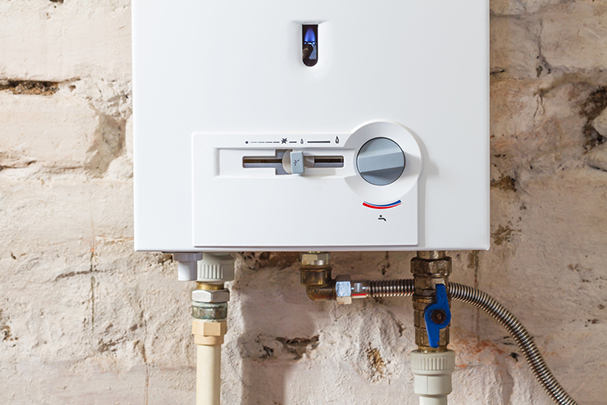
The adjustment is carried out with the valve open, taking into account the standard parameters specified in the operating instructions. Errors lead to the extinguishing of the burner flame.
The temperature of the water entering the tap from the column directly depends on the gas flow rate. To decrease or increase it, the gas flow rate is correspondingly decreased or increased.
The adjustment process is as follows:
- close the gas supply valve;
- set the gas flow knob to minimum;
- open the gas supply valve;
- turn on the hot water tap;
- give a few minutes for heating;
- measure the temperature of the water coming from the tap;
- if the water is not hot enough, turn the gas flow knob one notch;
- continue adjusting until the required water temperature is reached.
If the heating capacity of the water heater does not allow heating the water to the required temperature even at the maximum gas flow rate, screw the water supply shut-off valve slightly. The volume of water entering the column will decrease, and its temperature will increase.
The combination of minimum water flow and maximum gas flow can lead to overheating, activation of the safety system and shutdown of the burner. In this case, you need to tweak the settings slightly to achieve the optimal balance.
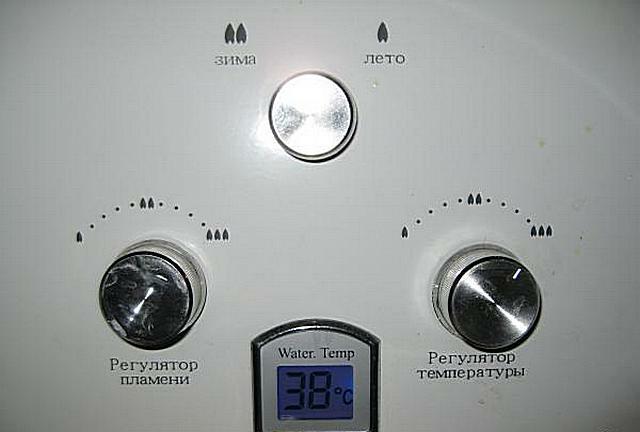
New generation gas water heaters are equipped with electronic displays that show the functions of the device, parameters required for setting, and operating characteristics
In winter, the temperature of the water in the mains can drop to 4 degrees, and in summer it can rise to 20 degrees or more. To avoid overheating or underheating of water during seasonal temperature changes, many modern columns are equipped with an additional handle. It must be set in a timely manner in a position corresponding to the season.
Conclusions and useful video on the topic
Owners of flowing water heaters sometimes encounter difficulties when lighting up - they cannot light a spark plug the first time. You can solve the problem yourself:
If the solenoid valve fails, the gas supply to the burners is stopped, the safety system is activated and the column is turned off. You can check the health of this component yourself:
Owners of gas water heaters just need to know the device design in order to understand in a timely manner what the problem may be and to prevent its occurrence. It is worth familiarizing yourself with typical malfunctions that occur during operation. It is possible that you can eliminate simple irregularities in work yourself.
Please write your comments in the block below, post a photo on the topic of the article, ask questions. Tell us about how you dealt with the problems of the gas water heater with your own hands. It is possible that website visitors can take advantage of your advice.
